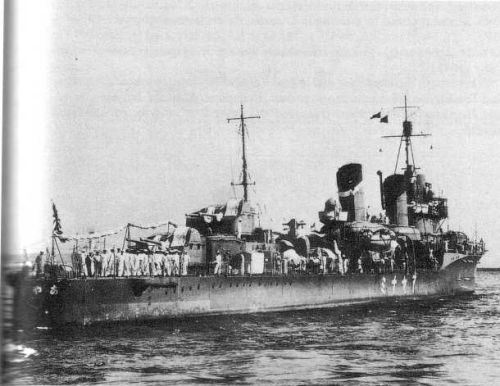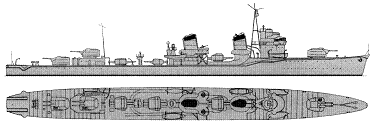
NAVYPEDIA
 Support the project with paypal
Support the project with paypal
Photo

Ayanami 1931
Ships
| Name | No | Yard No | Builder | Laid down | Launched | Comp | Fate |
|---|---|---|---|---|---|---|---|
| 吹雪 [Fubuki] (ex-第35駆逐艦 [35-go]) | Maizuru K K | 6/1926 | 15.11.1927 | 8.1928 | sunk 11.10.1942 | ||
| 東雲 [Shinonome] (ex-第36駆逐艦 [36-go]) | Sasebo K K | 8/1926 | 26.11.1927 | 7/1928 | sunk 18.12.1941 | ||
| 薄雲 [Usugumo] (ex-第37駆逐艦 [37-go]) | Ishikawajima, Tokyo | 10/1926 | 26.12.1927 | 7.1928 | sunk 7.7.1944 | ||
| 白雲 [Shirakumo] (ex-第38駆逐艦 [38-go]) | Fujinagata, Osaka | 10/1926 | 27.12.1927 | 7/1928 | sunk 16.3.1944 | ||
| 磯波 [Isonami] (ex-第39駆逐艦 [39-go]) | Uraga, Tokyo | 10/1926 | 24.11.1927 | 6.1928 | sunk 9.4.1943 | ||
| 白雪 [Shirayuki] (ex-第40駆逐艦 [40-go]) | Yokohama Co, Yokohama | 3/1927 | 20.3.1928 | 12.1928 | sunk 3.3.1943 | ||
| 初雪 [Hatsuyuki] (ex-第41駆逐艦 [41-go]) | Maizuru K K | 4/1927 | 29.9.1927 | 3.1929 | sunk 17.7.1943 | ||
| 深雪 [Miyuki] (ex-第42駆逐艦 [42-go]) | Uraga, Tokyo | 4/1927 | 26.6.1928 | 6.1929 | collision 29.6.1934 | ||
| 叢雲 [Murakumo] (ex-第43駆逐艦 [43-go]) | Fujinagata, Osaka | 4/1927 | 27.9.1927 | 5/1928 | sunk 12.10.1942 | ||
| 浦波 [Uranami] (ex-第44駆逐艦 [44-go]) | Sasebo K K | 4/1927 | 29.11.1928 | 6.1929 | sunk 26.10.1944 | ||
| 敷波 [Shikinami] (ex-第45駆逐艦 [45-go]) | Maizuru K K | 7/1928 | 22.6.1929 | 12.1929 | sunk 12.9.1944 | ||
| 綾波 [Ayanami] (ex-第46駆逐艦 [46-go]) | Fujinagata, Osaka | 1/1928 | 5.10.1929 | 4.1930 | sunk 15.11.1942 | ||
| 朝霧 [Asagiri] | Sasebo K K | 12/1928 | 18.11.1929 | 6.1930 | sunk 28.8.1942 | ||
| 狭霧 [Sagiri] | Uraga, Tokyo | 3/1929 | 23.12.1929 | 1.1931 | sunk 24.12.1941 | ||
| 夕霧 [Yugiri] | Maizuru K K | 4/1929 | 12.5.1930 | 12.1930 | sunk 25.11.1943 | ||
| 天霧 [Amagiri] | Ishikawajima, Tokyo | 11/1928 | 27.2.1930 | 11.1930 | sunk 23.4.1944 | ||
| 朧 [Oboro] | Sasebo K K | 11/1929 | 8.11.1930 | 10.1931 | sunk 16.10.1942 | ||
| 曙 [Akebono] | Fujinagata, Osaka | 10/1929 | 7.11.1930 | 7.1931 | sunk 13.11.1944 | ||
| 漣 [Sazanami] | Maizuru K K | 2/1930 | 6.6.1931 | 5.1932 | sunk 14.1.1944 | ||
| 潮 [Ushio] | Uraga, Tokyo | 12/1929 | 17.11.1930 | 11.1931 | damaged 14.11.1944, never repaired |
Technical data
| Displacement standard, t | 1750 |
|---|---|
| Displacement full, t | 2097 |
| Length, m | 111.9 pp 115.3 wl 118.4 oa |
| Breadth, m | 10.4 |
| Draught, m | 3.20 |
| No of shafts | 2 |
| Machinery | 2 sets Kampon geared steam turbines, 4 Kampon boilers |
| Power, h. p. | 50000 |
| Max speed, kts | 38 |
| Fuel, t | oil 500 |
| Endurance, nm(kts) | 4700(15) |
| Armament | 3 x 2 - 127/50 3-shiki, 2 x 1 - 7.7/80, 3 x 3 - 610 TT (15), 2 DCT (18), 18 mines |
| Complement | 197 |
Standard scale images

Fubuki 1928

Akebono 1941
Graphics
Project history
The history of creation of Fubuki class destroyers, or "special type" goes back to 1922, in which Japan has signed the Washington agreement according to which IJN can had destroyers with 201600t total displacement. Taking into account that Naval Staff plans provided to have 144 destroyers, standard displacement of each ship was limited by 1400t. This quantity was obviously insufficient for creation of the rigorous design, especially taking into account necessity of increase in a stock of fuel for actions in Pacific ocean at a great distance from bases. Eventually, in the Naval Staff it have decided to compensate a lack of tonnage by quality indicators of separately taken ships, having raised their displacement to 2000t. In October, 1922 there was a technical design of "special type" destroyer, or Toku Gata (2000t, 40kts, 2x2 120mm guns, 76mm AA gun and 6 610mm TT). During designing characteristics have undergone some changes: displacement has decreased to 1900t, 120mm guns have given way to 127mm, there was third triple TT, and speed has raised to 42kts. In April, 1924 design has been submitted to considering in Naval Staff, hence after detailed analysis it have shipped on finishing: designers were offered to lower whenever possible displacement, simultaneously having strengthened artillery, at least and by speed. After entering of corrections and repeated discussion the design (1680t, 35kts, 3x2 127mm guns, 1 76mm AA gun and 2 40mm MGs, 9 610mm TT) have approved in 1926.
First five ships (No35-39) have been ordered under the 1923 Programme, and following four (No40-43) under the special order in November, 1925. After some delays called financial troubles, orders have proceeded, and under the 1927 Programme 15 ships were laid down. In 1928 in the Japanese Navy have refused numbering of destroyers, therefore the ships of "special type" were commissioned under names.
Destroyers of "special type" became the first-ever ships of this class on which the main artillery took places in waterproof turrets with splinterproof protection. For the first time in the Japanese practice destroyers have received 127mm/50 guns. Vertical aiming and ammunition feeding gears were hydraulic, but low feed rate reduced the importance of high elevation angle, therefore guns though were considered dual-purpose, as the antiaircraft acted unsatisfactorily.
In the course of building out-of-date 40mm Vickers MGs and 7.7mm MGs were refused. 13.2mm MGs intended for their replacement, but as the latter have appeared not ready, it was necessary to return 7.7mm (13.2mm MGs were installed in 1933-1934).
As building of the ships of "special type" was stretched more than for five years, at the expense of changes brought in the design destroyers of differ years of completing had a number of differences, therefore all series it is accepted to share conditionally on three groups.
On pooled into the first group ten ships (No35-44) there were turret mounts with an elevation angle 40°. The second group including following 10 destroyers (No45-54), differed in updated 127mm mounts with an elevation angle 75°, improved fire control system (that has demanded to enter additional level over a bridge) and less appreciable boilers air intakes. The third group included only 4 destroyers to which at the expense of raise of steam output of separate boiler it was possible to shrink their number from four to three. These ships differed hardly by shorter hull and smaller displacement, besides, first funnel in which smoke duct from only one boiler was deduced, was notably more thin, than on 1st and 2nd series of "special type" destroyers. Hibiki became the first all-welded destroyer of the IJN.
Occurrence of the ships of "special type" has called the big resonance in naval societies of all world. Power of armament seemed disproportionate to the moderated, in general, displacement, however outside of Japan very few people guessed, what price should be paid for this achievement. To these destroyers lacks, characteristic were peculiar to all Japanese ships of that time: first of all, excessive upper weight and stability which has worsened because of it. For achievement of the high requirements advanced by the Naval Staff concerning speed, arms and an endurance at the limited displacement designers had to show a considerable ingenuity. The weight decreased in all possible ways, in particular, at the expense of creation of the lightened machinery, usage of light alloys in a construction of superstructures and wide using of welding in hull construction. Despite it ships have appeared are supercharged, especially it concerned 2nd groups: their turrets have gone out on 20% more heavier, and bridges on one level higher. Besides, TTs received shields that has given an additional increase of the upper weight. Taking into account that arranged low in the hull machinery has been lightened, the stability was moderated to a dangerous limit. That fact, that at the new Japanese ships not everything is all right with stability, was acknowledged for the first time on March, 12th, 1934 when the torpedo boat Tomozuru has overturned. Assumptions were come out, as new destroyers are dangerous in this respect but before something has been made, there was "an incident with the Fourth fleet": during a storm fore ends of Hatsuyuki and Yugiri broken off, three ships have lost a part of superstructures, four more have received various hull damages. Though any of the ships was not lost, it has demonstrated serious lacks of destroyers of "special type". For position correction thorough reconstruction of all ships constructed late 1920s - early 1930s has been conducted. On all destroyers of "special type" it have moderated height of bridges and funnels, ammunition stowage was decreased. By eight last ships new lightened turrets with an elevation angle 55° were installed. Besides, they have significantly strengthened hulls, and nearby 40t of solid ballast was stowed in holds. As a result standard displacement has increased from 1750 to 2090t, speed has decreased to 34kts.
Modernizations
1933 - 1934, all: - 2 x 1 - 7.7/80; + 2 x 1 - 13.2/76
1935 - 1937, all survived: ballast was added; displacement increased to 2090 / 2570t, maximal speed fell to 34kts, fuel stowage was 475t; - 2 x 1 - 13.2/76; + 2 x 2 - 25/60 96-shiki, 93-shiki sonar
late 1942, all survived: + 2 DCT (36 totally)
1943 - 1944, all survived: new turrets were mounted with maximal elevation angle 75°. - 1 x 2 - 127/50 (No 2), 1 x 2 - 25/60; + 4 x 3 - 25/60 96-shiki, 4 x 1 - 13.2/76, 2-shiki 2-go radar
mid-1944, all survived: + 8 x 1 - 25/60 96-shiki, (2 - 6) x 1 - 13.2/76
1944, some survived: + 3-shiki 1-go radar
Naval service
29.6.1934 Muyuki was sunk at collision with destroyer Inazuma.
Shinonome 18.12.1941 was lost on Dutch minefield at off Borneo (under other data was sunk by Dutch aircraft or by mine laid by Dutch flying boat). Sagiri 24.12.1941 was sunk at Sarawak by Dutch submarine KXVI. Asagiri 28.8.1942 was sunk N off Sawo by USMC aircraft. Fubuki 11.10.1942 was sunk in battle at Cape Esperance (Guadalcanal) by gunfire of US cruisers San Francisco, Sault Lake City, Boise, Helena and destroyers of TF64.2. Murakumo 12.10.1942 was sunk at Sawo by US Marine Corps aircraft. Oboro 16.10.1942 was sunk NE off Kiska by US Army aircraft. Ayanami 14.11.1942 was sunk at Sawo by gunfire of US battleship Washington. Shirayuki 3.3.1943 was sunk in Bismarck sea by US Army aircraft. Isonami was hard damaged 1.12.1942 by US aircraft at Boona Island, 9.4.1943 she was sunk SE off Celebes by US submarine Tautog. Hatsuyuki 17.7.1943 at Bougainville was sunk by US Army aircraft. Yugiri 16.5.1943 was hard damaged at Kavieng by US submarine Grayback, 25.11.1943 she was sunk E off Cape St. George (New Ireland) by US destroyers Charles Ausburne,Claxton and Dyson. Sazanami 14.1.1944 was sunk SE off Yap by US submarine Albacore. Shirakumo 16.3.1944 was sunk E off Hokkaido by US submarine Tautog. Amagiri 5.11.1943 was damaged by US carrier aircraft at Rabaul, 23.4.1944 she was lost S off Balikpapan on a mine. Usugumo 8.7.1944 was sunk SW off Paramushir by US submarine Skate. Shikinami 12.9.1944 was sunk S off Hong Kong by US submarine Growler. Uranami 26.10.1944 was sunk N off Panay (Philippines) by US carrier aircraft. Akebono 13.11.1944 was sunk at Cavite (Philippines) by US carrier aircraft. Ushio 14.11.1944 was hard damaged by US carrier aircraft in Manila Bay, towed off to Japan, but to an end of the war repair is not completed.
 HOME
HOME FIGHTING SHIPS OF THE WORLD
FIGHTING SHIPS OF THE WORLD JAPAN
JAPAN TORPEDO SHIPS
TORPEDO SHIPS FUBUKI destroyers (1928 - 1932)
FUBUKI destroyers (1928 - 1932)
